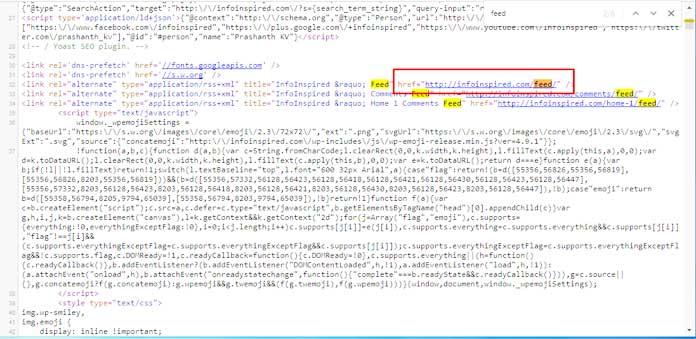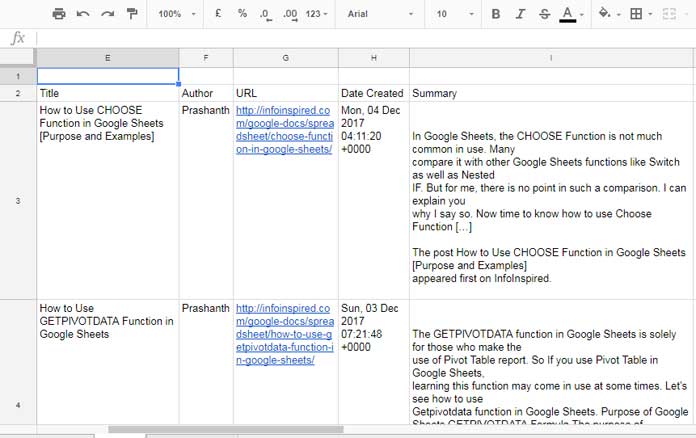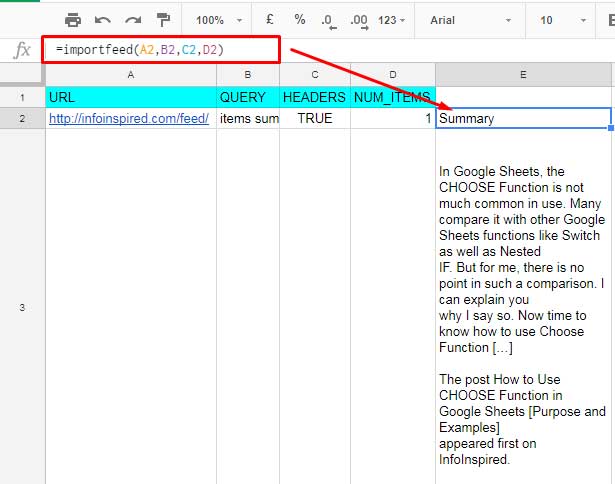You can create your own feed reader to read the latest contents from your favorite blogs. With IMPORTFEED function in Google Sheets, you can easily achieve this.
Then how to use IMPORTFEED function in Google Sheets?
You need not be a spreadsheet geek to do this. Even if you have limited Excel exposure, you can create your own feed reader in Google Sheets.
Get a glimpse of the latest articles that your favorite bloggers publish that from within your spreadsheet.
Purpose of Google Sheets IMPORTFEED Formula
You can use Google Sheets IMPORTFEED formula to import RSS or ATOM feeds, that in human-readable format in a Google Doc Spreadsheet.
You can have great control over such feeds using this function.
How to Use IMPORTFEED Function in Google Sheets
Syntax:
IMPORTFEED(url, [query], [headers], [num_items])
In earlier occasions, many times, when dealing with Google Sheets functions, I just skipped the syntax part without much detailing. Because I was aware that the examples can convey the details.
This time, I think, I should first explain the syntax part, then move to examples. Then only you can learn how to use IMPORTFEED function in Google Sheets clearly. So here we begin.
URL – URL is the RSS or ATOM feed URL of your favorite blogs on the web. If you ask me how to find a blog or webpage’s RSS or ATOM feed URL, my answer is to look at the page source. How?
For example, to find the RSS feed of my blog, just do a right-click anywhere on the screen and click on “View Page Source”.

Alternatively, you can apply keyboard shortcut Ctrl+U (on Google Chrome).
Then search for the keyword “feed” to find the feed URL of this site. This URL you can use with Google Sheets IMPORTFEED function.

QUERY – In order to pull RSS feed data using the IMPORTFEED function, the above URL is only required. Query and other components in the function are optional.
But to have a better control of your imported feed, you should know what are the other components.
The first one is a QUERY. Remember! This has no relation to the Query function.
Here the Query specifies what data to fetch from the given RSS or ATOM feed URL. By default, the query is “items”. I will explain different IMPORTFEED function Queries in the below examples.
HEADERS – This is also optional. But useful to show the fetched data with proper column headings. It accepts Boolean TRUE or FALSE.
NUM_ITEMS: You can limit the IMPORTFEED function to return the number of contents. When you omit this, the function will fetch all the recently published contents.
Now time to learn how to use IMPORTFEED function in Google Sheets with a variety of proper examples.
Google Sheets IMPORTFEED Function Examples
For the below example, I’m using my own blog feed URL. You can use any feed URL for your experiment purpose.
Example 1:
Use Importfeed function to fetch the item title of recent 2 posts.

Please note that you can replace the above cell reference in the formula as below. This is applicable to all the below IMPORTFEED examples.
=IMPORTFEED("https://infoinspired.com/feed/","items title",FALSE,2)
Example 2:
Use Importfeed function to fetch the item title of recent 2 posts with column headings.

Example 3:
Fetch Recent 2 Items with column headings.
This is similar to the above formula. But here just change the value in Cell B2 as “items” instead of “items title”.
The result would be as below and this is the best feed reader settings in Google Sheets using IMPORTFEED function.

Example 4:
Recent 1 Item Summary with column headings.

Conclusion
As above you can use different sheet tabs on your Google Sheets to fetch different feed content. That’s all.
Hope you could learn different formations of the function Importfeed in Google Sheets. Thanks for the stay. Enjoy!






















How can you have the Date Created and URL columns? I guess this formula depends on the structure of the feed? Some feeds I’ve tried have horrible structure.
Hi, Trang,
Use Query with the IMPORTFEED function.
Example:
=query(IMPORTFEED("https://infoinspired.com/feed/","items",true,10),"Select Col3,Col4")OMG, I don’t even know that this is possible. Totally forgot about Query function. Thanks for sharing.
Hi, how can I feed the data from https://rss.weather.gov.hk/rss/CurrentWeather.xml ?
From its filename, it is XML format, the HTML page is rendered with its XSL. How can I get only the location and degrees?
Best regards,
Kelvin
Hi, Kevin,
Maybe this helps.
=ArrayFormula(transpose(split(ArrayFormula(query(trim(IMPORTFEED("Enter URL Here")),"Select Col5 where Col5 is not null limit 1",0)),";")))Replace ‘Enter URL Here’ with the URL.
Best,
Hi, is there a way to feed a RSS every time a sheet is modified? I need this to create push notifications.
Thanx
Hi, Beppe,
Sorry, I don’t have a solution to offer!
Best,